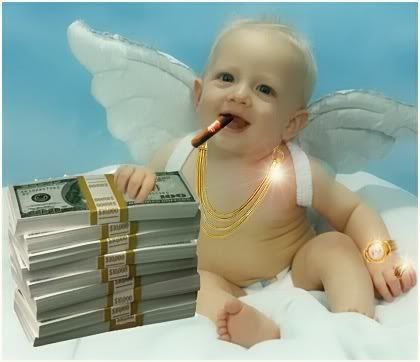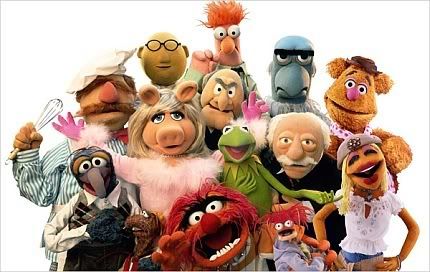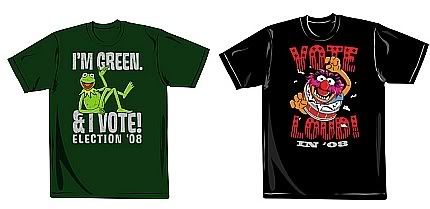Gayadas de Caliman13
caught my eye surfing.....
Thursday, October 2, 2008
Wednesday, October 1, 2008
La Olla Arrocera.
Dining & Wine |
| The Steamy Way to Dinner By JULIA MOSKIN Published: September 30, 2008 |
 Francesco Tonelli for The New York Times |
| SHIRLEY CHAN, a Chinese-American Web site designer, was born in Hong Kong, lives in Brooklyn, and has never cooked a pot of rice in her life. "One billion Chinese people cannot be wrong about rice," she said: virtually every household has at least a basic rice cooker. As a child, it was her chore before each meal to wash the rice, measure it into the machine, and press the button. "It always, always comes out perfect," she said. "Until I came here, I never even knew rice could burn." Although rice cookers are gaining in popularity in the United States, with a respectable 3 million sold last year, they are still not standard equipment. But American cooks with Asian, Middle Eastern or Caribbean traditions hovering over the kitchen often find them indispensable, and surprisingly adaptable. Domingo Guillen uses his to make vast batches of Puerto Rican arroz con gandules, rice and peas, before a weekly domino game at his apartment in the Inwood section of Manhattan. Fairuza Akhtar, a restaurant owner in Jackson Heights, Queens, who was born in Pakistan, has developed a quick method for making fragrant, creamy biriyani with whole spices and bites of chicken, at home in her rice cooker. "My mother would fall down in a faint," she said, referring to the traditionally reverent attitude toward biriyanis in Northern India and Pakistan. "But rice cookers are the way of the modern world." Ryosuke Tokuji, a graphic design student in Tokyo who lives in a dorm room with no kitchen, does all her cooking in a rice cooker. Like many larger models, hers has a built-in steamer, which she uses for dumplings, savory egg custards (chawan mushi) and fish. Ms. Tokuji has even baked a sweet, buttery loaf of bread in her rice cooker, based on a recipe from a popular television show about a superhero's quest to develop a "national loaf" for Japan. "It took all day, but it was very interesting," she said. Cooking foods other than rice in a rice cooker is like baking a layer cake in an Easy-Bake oven: best approached with patience, curiosity and something to snack on in the meantime. Some people cook in their rice cookers because they have little choice: they live in tiny spaces, or can't afford a stove, or live in sweltering climates where cooking on the stove or in the oven makes the kitchen too hot. But many just can't resist taking their machines out for a spin. John Youngsun Park, a designer of video games in the San Francisco Bay Area, blasts the heat on his Sanyo to make noo roong ji, the toasted crust of rice that forms at the bottom of the traditional Korean stone rice pot. "You just want to see what it can do," Mr. Park said. In fact, it can poach, steam and simmer, as well as turn out a crisp noo roong ji. "People love that toasted-rice taste," he said. "It's even a flavor of ice cream in Seoul." (Japanese cooks, however, consider toasted rice overcooked and highly undesirable. The unwanted crust left stuck to the bottom of the rice cooker is called okoge the same word used as slang for a single woman who spends a lot of time with gay men.) |
 Francesco Tonelli for The New York Times ADAPTABLE Bibimbap with spinach and salmon. |
A basic rice cooker consists of a nonstick metal bowl set inside a plastic-and-metal housing, with a heat source on the bottom. To cook plain rice: add rice, measure water, press start, walk away. The machine brings the mixture to a boil, reduces the heat for a prolonged simmer, then switches to a very low setting to keep the cooked rice at serving temperature. How does the machine know when the rice is done? A built-in thermostat tracks the temperature of the bubbling mixture of rice and water. When the water boils and turns to steam, the temperature in the pot begins to rise, which signals the cooker to switch to warm. But it's easy to override the machine's small brain. Press the "cook" button, melt butter in the bowl, and sweat a finely diced shallot in it until soft then add rice, broth and saffron strands, and start the machine again to make a daffodil-yellow pilaf. Cook some short-grain rice, then drizzle in some sesame oil and switch back to "cook," mix in some kimchi and break eggs on top for a simple bibimbap, the Korean-American staple of rice "and whatever is in the refrigerator," Mr. Park said. Make grits, risotto or any grain cooked by the absorption method simply by adding extra liquid and stirring often. The machine has plenty of built-in cushions for the cook: the temperature never gets very high, the surface is nonstick, and everything happens in a kind of slow-motion. |
 Francesco Tonelli for The New York Times Chicken with basmati rice and cilantro. |
| The first models were sold in Japan in the 1950s, to mimic the shape and slow-cooking method of the traditional Japanese rice pot. Electricity was just becoming widely available in Asia, and the rice cooker was the first appliance designed specifically for an Asian kitchen. It was enthusiastically adopted, especially by the many Japanese women who entered the workforce in the 1950s. The new-model rice cookers, with digital menus and "fuzzy logic" operation, are actually less flexible than their one-button ancestors. The machines have their own ideas about brown rice, porridge, sushi rice and sometimes more. These cookers produce perfect results but require peace and quiet to perform their mystical work. "Fuzzy logic" is a way of describing situations that cannot be described in absolutes: yes or no, true or false, white rice or brown. Fuzzy logic is used in automated technology that must sense and adjust for various factors, like mixing cement (depends on humidity) and changing traffic lights (depends on traffic). In rice cookers, fuzzy logic can take into account the type of grain, its age and hardness and its desired consistency. Frequent rice cooks who work with a variety of grains and have room on the countertop will not be disappointed by the performance of these machines. Inexpensive rice cookers with just two settings can handle many of the same tasks, though they require more attention. A mastery of regular binary logic is quite sufficient to operate these simpler models, but the initial process of measuring the rice and water can be mystifying. There are many recipes for rice cooker dishes, on the Internet and in books like "The Ultimate Rice Cooker Cookbook" (Harvard Common Press, 2002), but many of them are really recipes for steaming, or involve other pots and appliances. The most intriguing recipes are those that have been developed, out of necessity or curiosity, entirely for the rice cooker, like the ones here. Hui Leng Tay, a food blogger in Singapore, is unusually committed to her rice cooker, having developed recipes for fried rice, bibimbap, Thai tom yum rice and many others at teczcape.blogspot.com. She sees herself as seeking the elusive grail of cooks everywhere: the make-ahead, not-too-unhealthy, tasty meal. "I try to figure out which ingredients get better when kept over low heat for a long time, like cabbage and onions, and which ones get droopy," she said. Shabnam Rezaei, an editor and producer, who grew up in Tehran in the 1970s and now lives in New York and Vancouver, said that a fundamental expectation for women in Iran is the ability to make tender, fluffy rice. "There are all kinds of jokes in Farsi about how women must keep their eyes on the rice pot or they will not find a husband," she said. Making Persian rice correctly requires the cook to rinse and soak the grains, parboil them, dump them out, oil the pot, put the rice back and steam it, covered with a towel, until tender and surrounded by a golden crust on the bottom and sides called the tahdig. It is perhaps not surprising that rice cookers, with a built-in tahdig function, have become standard in Iran. "In a culture where rice is so important, such a staple," she said, "the rice cooker can bring a kind of liberation for women." |
| Related
|
| Ratios in Translation Rice cookers are usually sold with a plastic measuring cup that holds about three-quarters of an American cup. It is the size of the traditional Japanese tool for measuring rice: the masu, a wooden box sometimes used for drinking cold sake. "Measuring seems to be the most difficult part for our American buyers," said Marilyn Matsuba, the American marketing manager for Zojirushi, the company that sells the most rice cookers in Japan. She said cooks can use the same proportions as when cooking rice in a pot. A ratio of two cups liquid to one cup long-grain rice will work; for short-grain rice, the ratio of water to rice is about one and a quarter cup to one cup. An Asian measuring method is surprisingly reliable: with the tip of the index finger resting on the top of the rice, add water until it rises just above the first knuckle. A rice cooker can accommodate easygoing approaches to measurement, because its long steam bath evens the texture of the rice. |
| Open article at NYT Web Site. |
Tuesday, September 30, 2008
Seis lecciones que deberíamos de haber aprendido.
 |
| 6 Lessons We Should Have Learned Already Posted by Paul B. Carroll and Chunka Mui on September 30, 2008 1:39 PM |
 |
| |
| Great leaders are forged in times of crisis. The credit crisis that surrounds us creates an opportunity to learn--but only if we begin by understanding that the crisis is not the result of one-time mistakes or bad luck. Instead, the collapse of Washington Mutual, Wachovia, Lehman Brothers, AIG, Bear Stearns, Merrill Lynch, and others soon to fall stem from discredited strategies that should have been avoided, according to the research into 2,500 major failures that we did for our Harvard Business Review article, "Seven Ways to Fail Big" and for our recently published book, Billion-Dollar Lessons: What You Can Learn from the Most Inexcusable Business Failures of the Last 25 Years. Here are six lessons that, had they been learned a decade ago, would have kept us from being in our current mess: 1. It doesn't work to let dealmakers make all their money up front. Whether it's lenders hawking mortgages, bankers pushing bonds, or salespeople closing contracts before the end of the quarter, dealmakers have to have responsibility for the health of those decisions years down the road. Where possible, the individuals who make the deals should also have their compensation depend on the long-term performance of those deals. Green Tree Financial showed how dangerous it can be to separate up-front fees from long-term responsibility. In the 1990s, Green Tree offered mortgages on mobile homes that made no long-term sense -- the mortgages lasted 30 years, while the underlying assets had a useful life of just 10 to 15 years. Yet, because Green Tree employees from the CEO on down had so much of their pay tied to the growth in the number of mortgages, the company churned out flawed loans at an ever-accelerating pace. When problems started to surface, Green Tree actually managed to sell itself to Conseco for almost $6 billion in 1999. Conseco subsequently wrote off all the profits that Green Tree ever recorded and went into bankruptcy proceedings. Subprime lenders, having missed the Green Tree lesson, likewise became addicted to up-front fees and generated an astonishing number of bad loans that were turned into securities and sold. 2. Risks may correlate more than you think. In other words, a single problem can take you down if it's severe enough. Long Term Capital Management thought it had diversified its risks in the 1990s but found its whole portfolio turning sour simultaneously and collapsed in 1998. Having missed that lesson, this time around companies such as Merrill Lynch and WaMu built huge portfolios of mortgage-related securities that relied on historical data suggesting that housing markets were localized -- in other words, the market in Denver was independent of the market in Sacramento, which was independent of the market in Pittsburgh. In fact, the credit crunch has clobbered all markets and all classes of lenders. 3. In a crisis, liquidity can disappear overnight. LTCM thought that, in the event of problems, it could always unwind its positions in orderly fashion. In fact, all buyers disappeared. The same thing happened to Merrill, WaMu and others. The market got so scared so fast that nobody would buy their debt portfolios at almost any price. While Bank of America might have bought Merrill at a bargain for $50B, they also acquired $64B of toxic debt that will eventually mushroom the true cost of the acquisition. 4. It's incredibly dangerous to buy a business unless you understand it in excruciating detail. Conseco showed the danger. It had a great record of buying and integrating companies, but they were all in insurance. Conseco didn't know anything about mortgages. It was so clueless about the problems with Green Tree's business model that it actually stepped up the mortgage business, right to the point where it collapsed. AIG repeated the mistake when it started offering credit-default insurance on mortgage-backed securities that it didn't understand. Merrill made this mistake when it decided it could copy Goldman Sachs and invest its own capital in what turned out to be toxic loans. (And Bank of America may have made this mistake when it agreed to buy Merrill, whose retail brokerage operation, investment banking unit and investment portfolio are outside its expertise.) As a colleague of ours says: Don't assume someone smarter than you will understand the risks you're taking on. 5. Whenever anyone says they've managed to do away with risk, head for the hills. LTCM said its portfolio was impervious to risk. AIG and others said the same thing about the securities that were built based on subprime mortgages. We've no doubt that yet others will be saying the same as they argue for ways to take advantage of others' mistakes as the current crisis unfolds. 6. Perhaps the greatest lesson of all is that bad strategies can happen to great companies and smart people, even those acting on seemingly thorough analysis and the best of intentions. The humility that comes with this lesson should cause the smartest companies and managers to instill process and cultural mechanisms that absorb these lessons and avoid such mistakes in the future. (We don't have the space here to go into it, but that has a lot of do with creating a culture of constructive debate and deliberation. We discuss this in our HBR article and have even made the relevant chapter free at our web site.) The next generation of great leaders will be the ones who absorb these lessons. Everyone else is doomed to repeat the same mistakes. Paul B. Carroll wrote for the Wall Street Journal for 17 years. He is the coauthor of Billion-Dollar Lessons and the author of Big Blues: The Unmaking of IBM.Chunka Mui is the coauthor of Billions-Dollar Lessons and the coauthor of Unleashing the Killer App. He is a fellow at Diamond Management & Technology Consultants. For more on their work, visit www.billiondollarlessons.com |
| Copyright © 2008 Harvard Business School Publishing Corporation. All rights reserved. |
Inversiones para afrontar la crisis bursatil.
Regresan los Muppets !!!!!!
FILM. |
| Fuzzy Renaissance By BROOKS BARNES Published: September 18, 2008 BURBANK, Calif. |
|
|
| POOR Miss Piggy. Like most aging stars in Hollywood, that prima donna pig, along with most of her Muppet pals, has struggled to find substantial roles. Almost nobody under the age of 30 remembers "Pigs in Space." All everyone wants to talk about is this Hannah Montana person. What's a down-on-her-luck puppet to do? The Walt Disney Company feels her pain. Since it bought Miss Piggy, Kermit and crew in 2004, executives have struggled to figure out how to put them to work. Efforts in 2005 to rejuvenate the furry creatures created by Jim Henson sputtered as the Muppets got lobbed between corporate divisions, and a new television series a parody of "America's Next Top Model" called "America's Next Muppet" died in the planning stages. Now Disney is giving it another go by revving up the full power of its culture-creating engines. Instead of the take-it-slow approach, this time the Muppets are getting the "Hannah Montana" treatment, being blasted into every pop-culture nook and cranny that the company owns or can dream up. The balcony blowhards Statler and Waldorf would be impressed with the ambitiousness of the plan even if it does come with equally outsize challenges. "We think there is a Muppet gene in everybody," said Lylle Breier, a Disney executive who is the new general manager of Muppets Studio. Disney Channel is presenting new specials the first ran last month, the second will be shown in October in which Muppets interact with "High School Musical" stars and the Jonas Brothers, among other teenage wunderkinder. A stream of comic videos is in production for Disney.com, where a new Muppet channel recently made its debut, and viral videos have been unleashed on YouTube. NBC will broadcast a Christmas special in December, and special skits will arrive on certain ABC DVD releases. (One skit with the working title "Desperate Housepigs" is on a coming "Desperate Housewives" DVD.) A new feature film, still untitled, is planned for 2010, with more in development. Meanwhile the Muppets will work overtime elsewhere, appearing on a new float in the Macy's Thanksgiving Day Parade, on "Nightline" interviewing political candidates and on various talk shows. More Muppet-theme attractions are being discussed for Disney theme parks. And then there is the merchandise. Coming soon: Muppet clothing at Urban Outfitters and Limited Too stores; Muppet-theme items like stuffed animals and tote bags, at Macy's; and a Muppet boutique at the New York flagship of F. A. O. Schwarz. Disney does not want to create a flash in the pan; it sees the Muppets as a franchise that can sit side by side with, say, Winnie the Pooh. But creating any flash at all is the challenge. With the exception of a guest appearance here and there, the characters have largely been in cold storage for the last three years. And because the Muppets have been without a regular television gig for more than a decade, many children and younger teenagers don't know them. Ms. Breier said recent focus groups indicated that some children could not even identify Kermit and Miss Piggy, much less ancillary characters like Fozzie Bear and Gonzo the Great. The wisecracking, irreverent Muppets (a combination of puppets and marionettes) also don't fit that neatly in the Disney culture, as they differ from most of the company's bedrock characters in two big ways: Kermit and coterie were primarily created to entertain adults, and they live in the real world. Henson was so insistent that they stand apart from his "Sesame Street" creations in personality and tone that he (misleadingly) titled the 1975 pilot that would boost their careers "The Muppet Show: Sex and Violence." Undeterred, Disney expects the Muppets to expand their fan base beyond nostalgic older generations to the age group between 6 and 12 that has powered "Hannah Montana" and "High School Musical" into international blockbusters. But how do you make 50-year-old puppets, even those as beloved to many people as these, relevant in a "Wall-E" world? The Muppets are hardly moribund, but they do represent one of the most striking examples of franchise fumbling in Hollywood history. |
|
|
| "The Muppet Show" made its debut on CBS stations in 1976, introducing the classic characters Disney owns today. (The Muppet characters that populated the inaugural season of "Saturday Night Live" a year earlier were different.) "The Muppet Show" was full of song-and-dance numbers and skits, often featuring absurdist humor, along with backstage antics. Dancing chickens were thrown in for good measure. Some of the biggest names in entertainment at the time populated each episode. Rudolf Nureyev and Miss Piggy, clad in towels, sat in a sauna and sang "Baby, It's Cold Outside"; a bejeweled Elton John performed "Crocodile Rock" with Dr. Teeth and the Electric Mayhem, the show's house band. Witty, somewhat subversive dialogue and the hilarious-looking Muppets themselves quickly won audiences over. The show, which ran for five seasons, at one point was syndicated in 100 countries. The ubiquitous franchise spawned hit movies ("The Muppet Movie"), hit songs ("The Rainbow Connection"), loads of merchandise and, eventually, an animated series called "Muppet Babies." But those glory days are long gone. After Henson's death from a rare bacterial infection, at 53, in 1990 his five children took control of the company. They set about working on new adventures for the Muppets but not before dragging them into a nasty court fight with Disney over terms for a Muppet attraction Henson had completed for Walt Disney World. And the franchise's pop-cultural resonance slipped; the last Muppets movie, "Muppets From Space," sputtered at the box office in 1999. The next year Henson's heirs sold the family business to the German media company EM.TV and Merchandising for about $680 million. But as the German conglomerate slumped under crushing debt and an insider-trading and fraud investigation, the Muppets stagnated further. The Henson children later bought back the classic Muppets and the characters from the HBO series "Fraggle Rock" for $78 million (before selling the classic characters to Disney in 2004 for $75 million); the "Sesame Street" Muppets were sold to Children's Television Workshop. The family continues to operate the Jim Henson Company, which retains ownership of the Fraggles. But even Disney, skilled in immortalizing the vision of a single man, has struggled to rekindle the Muppet spark. Although Disney estimated three years ago that the Muppets would be generating about $300 million a year in merchandising sales by now, retail analysts say the total for 2008 will be closer to $50 million. Meanwhile Henson loyalists like the performer and puppeteer Frank Oz publicly criticized aspects of Disney's stewardship. Allowing Miss Piggy to serve as a Pizza Hut pitchwoman in a Super Bowl commercial created a major dust-up among fans, even though Henson himself was overtly commercial. (The piano-playing dog Rowlf was created in 1962 to sell Purina Dog Chow.) And family members have at times been frustrated at what they saw as Disney's lack of focus. "Have they been a little slow? Perhaps," said Brian Henson, the co-chief executive officer of the Jim Henson Company. "But the most important thing to us is that they are careful. Now, more than ever, we believe they are doing just that." Dick Cook, chairman of Walt Disney Studios and Ms. Breier's boss, attributed the pace to the scale of Disney's plans. "Developing the kind of high-quality entertainment we have planned for the global relaunch of the Muppets takes time," he said. In early August a motley group of puppeteers, lighting technicians, camera operators and Disney executives gathered on a Hollywood soundstage to work on Miss Piggy's comeback. She perched on the arm of Eric Jacobson, who performs the Muppet characters originated by Mr. Oz, stared blankly downward. A crew member brushed her hair and plucked a piece of lint from her forehead. "Miss Piggy, are you with us?" asked the director, Bill Barretta. In the scene at hand, destined for Disney.com, Miss Piggy would demonstrate her workout routine: bend at waist, pick up bonbon from box on floor, eat; repeat. "Kissy, kissy, it's moi," she said after the camera started rolling. Gently attaching the Muppets to today's touchstone issues healthy living, the environment is one way Disney hopes to make them more relevant to the young and the trend conscious. Hence Miss Piggy's donning of workout gear and Kermit's recent appearance on ESPN (yet another Disney outpost) chatting with athletes about being environmentally friendly. |
|
|
| Related Muppet Video Clips
SOUND MP3
|
|
|
| At the same time maintaining the core DNA of the characters is crucial, so as not to alienate an older generation with warm memories from their own childhoods. Miss Piggy, as a result, does not suddenly become a vegan; she communicates about exercise by talking about how she hates to exercise. Kermit does not pontificate on going green; he listens to others talk about it in his humble, unassuming way. "We want to be very, very careful that whatever we do is in the spirit of the Muppets and that we are enhancing the brand," Mr. Cook said. The new Muppet film, for instance, will be geared to a broad audience, but Disney understands the need it to retain an adult sensibility. Mr. Cook hired the team behind the raunchy comedy "Forgetting Sarah Marshall," Jason Segel (the writer and star) and Nicholas Stoller (the director), to deliver the script. Leading up to a film rather than starting with one reflects the feeling among studio executives that the film will make a bigger splash if the marketplace is prepped first. With merchandising partnerships like the one with F. A. O. Schwarz, Disney is also trying to tap into a retailing trend popular with children and teenagers: customization. American Girl Place stores, for instance, give shoppers the opportunity to design dolls to their specifications. F. A. O. Schwarz will do the same for Muppets fans. At the store's Muppet-theme boutique, customers (for $100) will pick a body shape from various styles and then accessorize it with "a huge variation of Muppet parts," said David Niggli, the president of F. A .O. Schwarz. (Versions will be sold on its Web site, fao.com.) The result will be what Jim Henson referred to as a "hand rod" Muppet: one hand goes inside the head of the puppet and the other holds thin rods connected to the puppet's hands, allowing for gestures. "Younger consumers expect to be able to immerse themselves in the brands they like, so this idea is spot on," said Samantha Skey, an expert on youth marketing at Alloy Media & Marketing. She added that as far as teenagers and children are concerned, "it's a great way to bring this brand back from the dead." That resurrection is being planned at Disney's headquarters in Burbank, inside what Ms. Breier has called the Muppets' war room. At a recent meeting the Muppets team watched a newly completed video for distribution on YouTube in which Sam, the moralistic eagle, and the rock star Animal, still chained to his drum set, perform "Stars and Stripes Forever" with a chorus of clucking chickens and other Muppets. Everyone in the room laughed. The viral videos have exploded on YouTube over the last month, giving Ms. Breier confidence that her strategy is starting to work. Four YouTube videos had been viewed a total of more than five million times as of Sept. 9, according to Disney research. And some parents are starting to notice that the Muppets are suddenly on the radar screens of their young children. "I tried getting them to watch DVDs of 'The Muppet Show' probably a year or two ago, and they weren't that interested," said Tom Weber, a New York father of two girls, ages 5 and 9. "But now that Disney is making its marketing push, they seem more aware and into it." Ellie Weber, the 5-year-old, confirmed it. "Miss Piggy is really funny," she said. "I like it when she plays with the froggy." |








